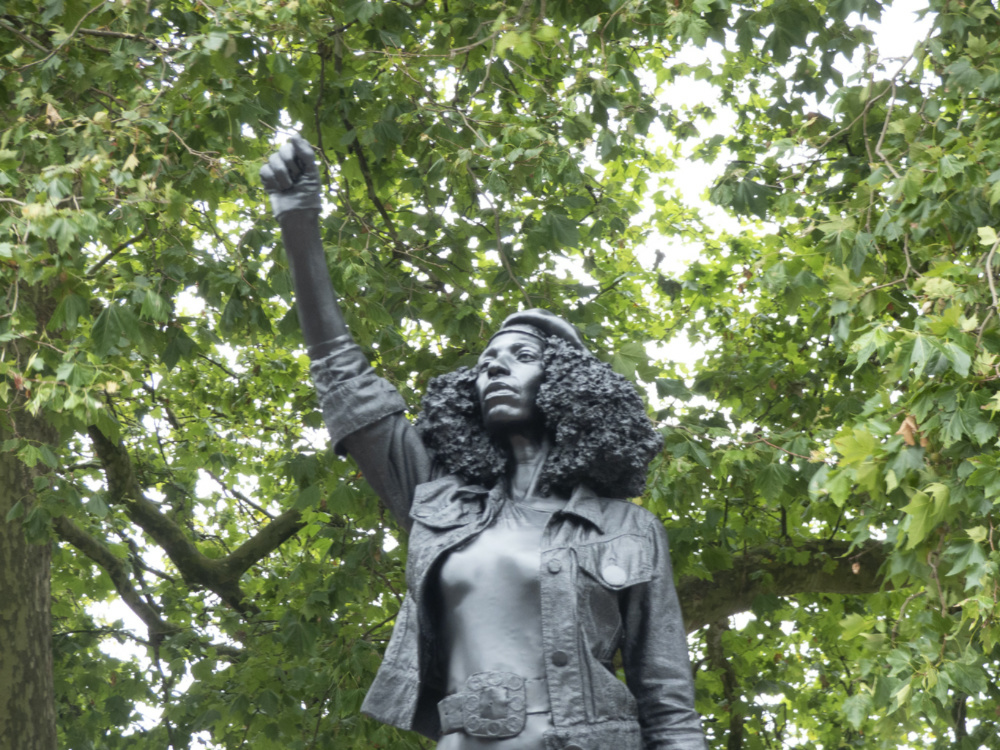London, UK
Thomson Reuters Foundation
The statue of a 17th century English slave trader toppled by anti-racism protestors in June was replaced on Wednesday by the sculpture of a Black protester with her fist raised in the air.
A monument to Edward Colston, who made a fortune trading West African slaves, was pulled down and pushed in the harbour of Bristol in southwest England last month by protesters following the 25th May death of African-American George Floyd in police custody.

Marc Quinn’s sculpture of protestor Jenn Reid. PICTURE: Sam Saunders (licensed under CC BY-SA 2.0)
The sculpture of Jen Reid, who was photographed standing on the plinth of Colston’s statue just after it was pulled down, was put up in a stealthy operation in the early hours of Wednesday by a team directed by artist Marc Quinn.
As debates rage from New York to Brussels over how to deal with monuments of those who profited from slavery, artists like Quinn are taking matters into their own hands.
Critics say replacing historical monuments with new ones without the consent of authorities is a form of vandalism but Quinn insists his team are breaking no laws and that now is the time for “direct action”.
What does slave trader Edward Colston’s statue replacement mean for monuments worldwide?
The bigger picture
The toppling of monuments honouring slave owners, Confederates and disgraced white leaders of decades past has opened up a debate over who should rise up to take their place.
From country singer Dolly Parton to LGBT+ activist Marsha P Johnson to Donald Trump, the internet is buzzing with ideas for new heroes.
Several online petitions and opinion pieces call for more statues of Black people, from politicians to war veterans to celebrities.
How was the Edward Colston statue replaced?
Quinn’s team photographed protestor Jen Reid from various angles in the black dress, hat and square buckle belt she was wearing the day the Colston statue was toppled to create a 3D printed replica of her image atop the plinth.
The life-seized, black resin sculpture of her was erected without any formal permissions with a crane and a team of people in Bristol’s city centre.
Although the artist and subject have said the statue is intended as temporary, Quinn has said it would be “extremely difficult to move.”
Why did they erect a new statue?
Quinn has long used his art for social justice, and has frequently worked with refugees and disabled people to draw attention to the inequalities faced by marginalised groups.
“Keeping the issue of Black people’s lives and experiences in the public eye and doing whatever I can to help is so important,” Quinn said in a statement on his website.
“Those of us who have privilege have a duty to be part of change.”
What will happen to the original statue?
The statue of the merchant who transported about 80,000 men, women and children from Africa to the Caribbean and the Americas was retrieved from the harbour in June.
Local authorities plan to display it in a museum, leaving intact the graffiti and ropes tied on by protesters.
Was it legal?
Many have described Quinn’s move as illegal vandalism, but he insists he and his team are breaking no laws.
Some forms of street art like graffiti are considered illegal under Britain’s Criminal Damage Act 1971 for the destruction or damage of property.
But the Reid sculpture was created so as not to harm the plinth and so it is unclear if this law applies to Quinn’s piece.
Avon and Somerset Police said that it was up to Bristol City Council to decide on the legality of the issue. Bristol City Council said it was a matter for the police.
What does it mean for other pulled-down monuments?
When years of campaigning through official channels in Bristol failed to remove the Colston statue, protesters took matters into their own hands.
In similar fashion Quinn bypassed bureaucracy, exposing a legal grey area and a possible model to others.
A key question for authorities is how inclusive the process will be.
“The future of the plinth and what is installed on it must be decided by the people of Bristol,” Bristol Mayor, Marvin Rees said in a statement.
“This will be critical to building a city that is home to those who are elated at the statue being pulled down, those who sympathise with its removal but are dismayed at how it happened and those who feel that in its removal, they’ve lost a piece of the Bristol they know and therefore themselves.”






